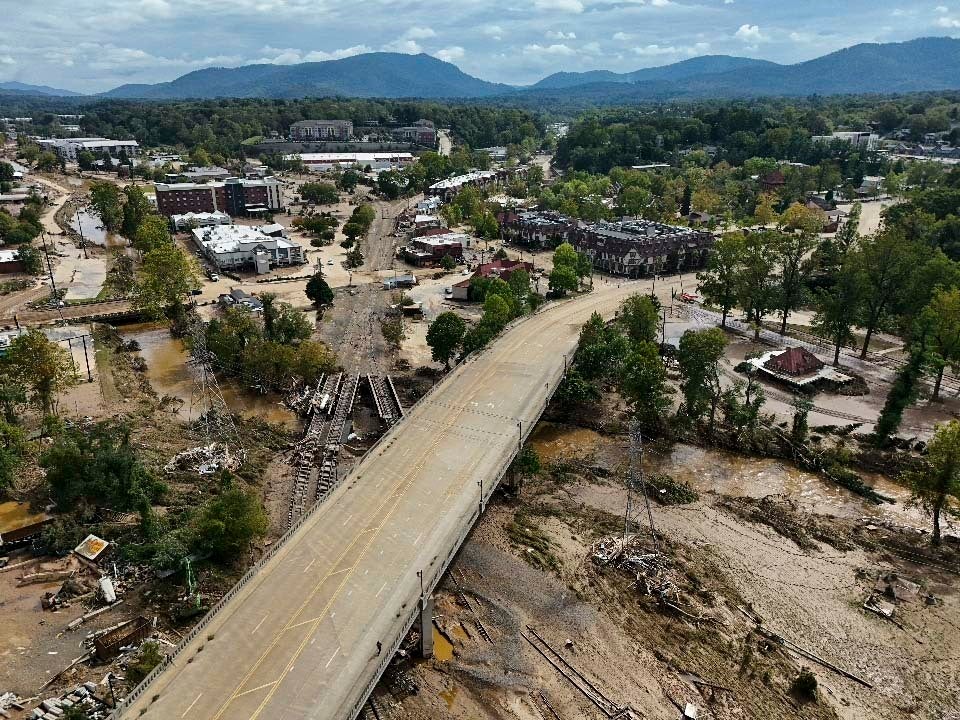After Hurricane Helene, the places I loved in Asheville look like they never existed
For North Carolinian Lauren Bulla, the fallout from the severe storms in her college town isn’t just shocking – it’s conjured up a particular type of grief she had not experienced, until now


Imagine the worst natural disaster documentary you’ve ever seen; people screaming for help, stuck on top of the roofs of their homes; cars crushed under fallen trees; incomprehensibly rapid and all-consuming flood waters. Now, imagine watching it through the eyes of your loved ones as they post videos of the devastation to social media.
I had no idea what was happening in North Carolina on Friday night until the following afternoon, after Hurricane Helene had wreaked havoc across the east coast. Although Asheville was my home for five years and many of my loved ones still live in the area, I was watching all the destruction play out online, from my flat in London.
To see videos capturing the places I once frequented with dear friends, knowing that there is nothing left – not even a single brick – is a particular type of grief I had not yet experienced. Asheville, to me, is where many of my friends’ first children were born, where we celebrated wedding days and graduations. I felt helpless and crestfallen as messages reading, “yeah, we are OK”, or, “yet to get access to food or water” or “my office is gone” came through on my phone. I could do nothing but watch and wait.
And the footage is truly horrifying. Entire neighbourhoods, businesses, buildings and highway systems have been completely erased. What remains is soggy, muddy, filth-soaked earth, spanning across the entire western region of the state. Hundreds of thousands of people are without electricity, food, or access to running water.
My heart raced as I immediately started messaging loved ones and close friends that still live in the area – some of those close to the worst of the flood zones, others late in their pregnancies – hoping for the best, but fearing the worst.
I spoke to one friend, Hannah Cate, on Instagram. “When we woke up we had no idea what was out there,” she told me. “It wasn’t until we heard the screaming that we knew something was terribly wrong. Walking from her family home, she witnessed “several people begging us to save them – hanging from trees and sitting on floating pieces of debris. We were completely helpless”.
The entire town of Marshall, which is about a 30-minute drive outside of Asheville, is now completely underwater. It’s unthinkable to me that just a few years ago I was there with one of my best friends, sitting near the old courthouse, sharing coffee and cookies. That area is now completely obliterated. State databases have documented that there are thousands of people unaccounted for.
I cannot describe adequately the distinctive, gut-wrenching feeling I get as I watch video upon video on Instagram. I’m glued to my phone, feeling a strange mix of guilt and helplessness, safe and dry in London – while entire streets are consumed by floodwaters and debris. That local bar we hung out in when we were all in our final years of college? Gone. Shredded. And now fallen power lines have electrified the area, making it even more dangerous.
For days, there was an area-wide curfew of 7.30pm, and no access in or out of the city, as most roadways were closed off. With the floodwaters subsiding, people have only now begun to review the sheer amount of damage – and it is much worse than what’s being reported online.
Highways and roadways have been annihilated, disconnecting smaller, adjacent neighbourhoods and towns – and leaving them without access to aid. Many people I know have been asked to check in on elderly relatives, as the storms have cut them off from their families. And there is another area still experiencing an internet blackout, meaning they have no clue what’s going on – or the extent of the fallout. Mudslides have consumed homes, whole neighbourhoods and towns.
State and national government is under criticism for the lack of engagement with the region and general incompetence regarding its lack of preparedness. Smaller towns outside of Asheville experiencing the worst of the neglect are being called “ghost towns,” with no aid in sight. Community members are putting themselves at risk, directing traffic, while the Asheville Police Department stands guard outside of grocery stores. In Swannanoa, right now, there is zero law enforcement. My friend told me her family’s coin shop was broken into and destroyed. It’s absolutely absurd.
What is heartening at this time is how communities are coming together to support one another. They are some of the most resilient people I’ve ever known – sharing resources, aid, communications and more. Local restaurants, breweries and shops are all offering water where they can, as well as free meals and groceries.
That is the Asheville I have always known and loved – and even if it is gone as I knew it, I look forward to the day I can once again return.
All I can hope is that people acknowledge the sheer amount of damage from afar and are generous enough to donate in assisting a region desperately in need of help, love and care at a very dark hour. Where can you donate? Beloved, Appalachians for Appalachia, Mutual Aid Disaster Relief.






Join our commenting forum
Join thought-provoking conversations, follow other Independent readers and see their replies
Comments